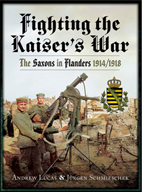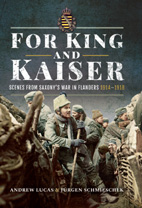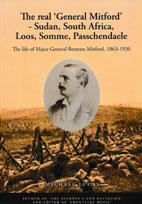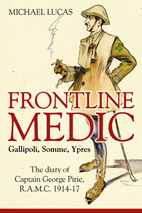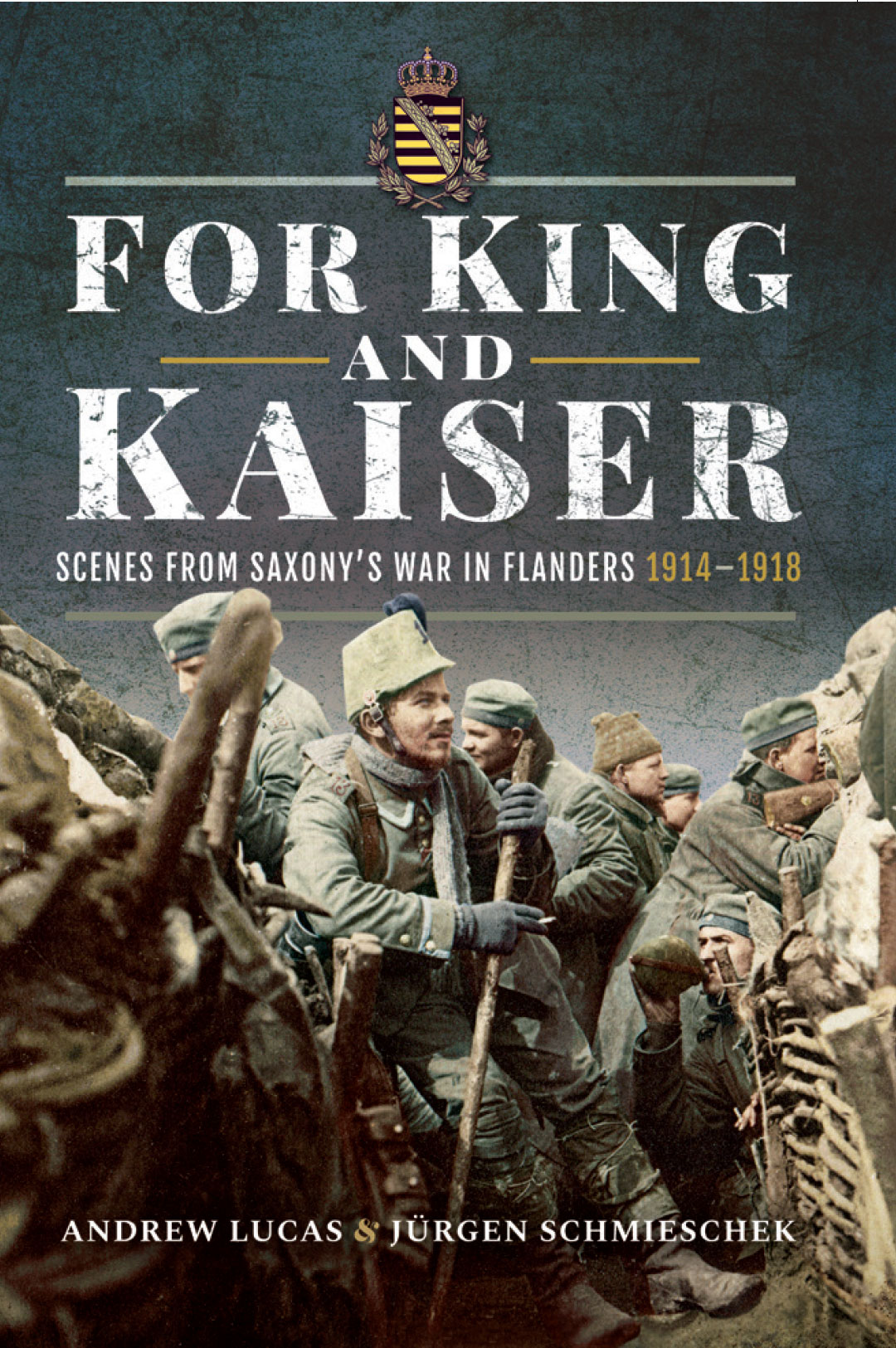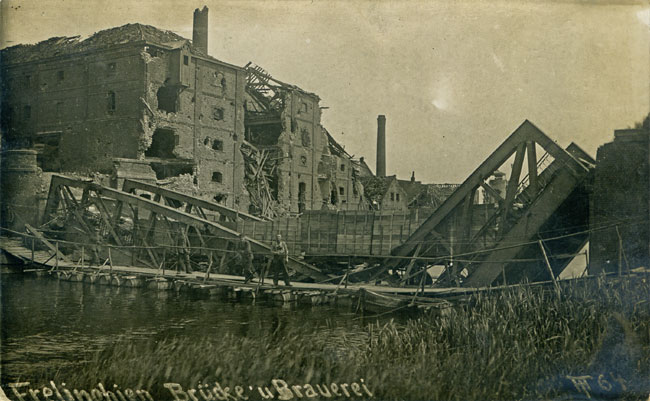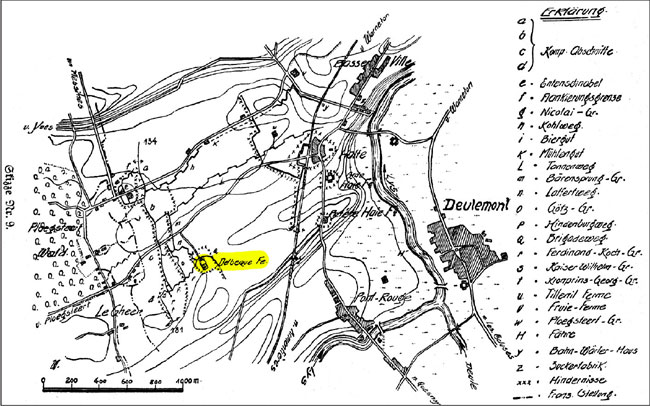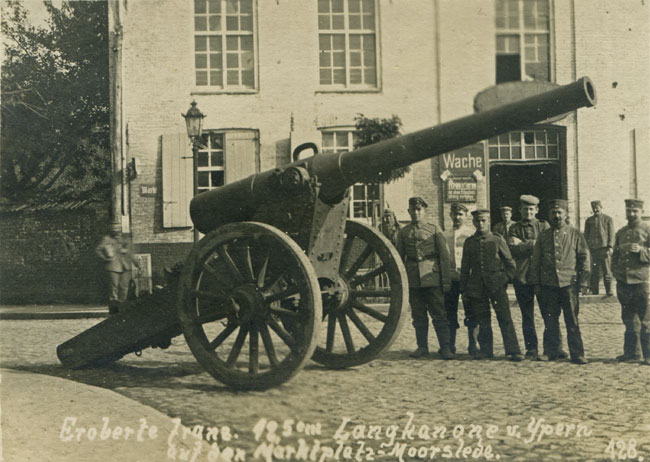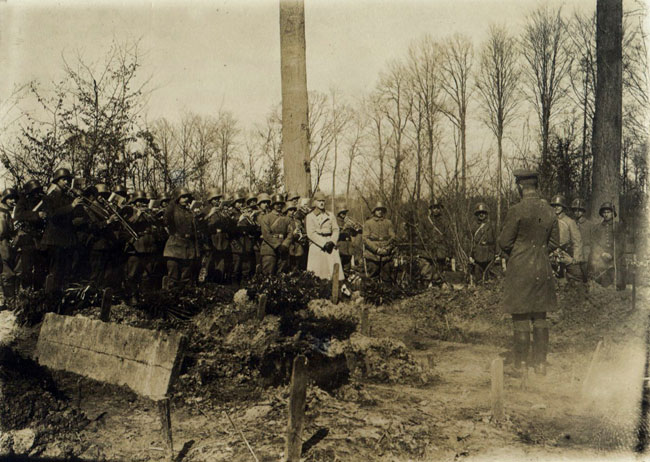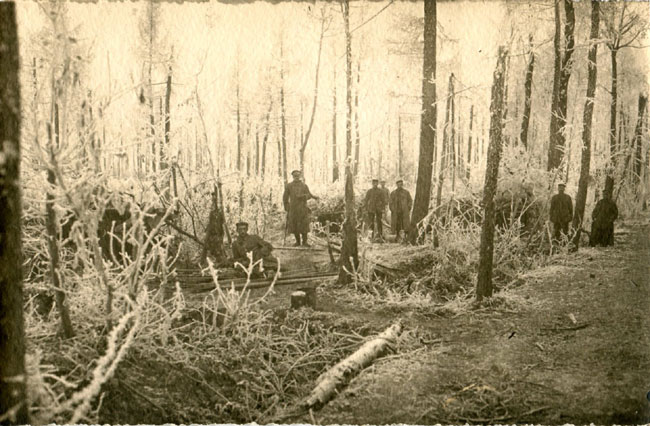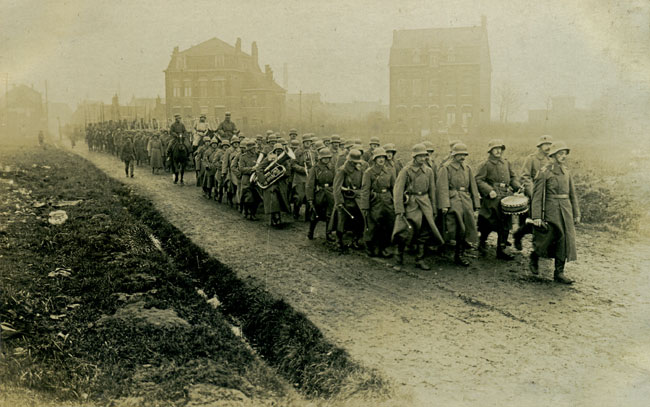This article elaborates on what you can expect to find in each chapter of our new book For King and Kaiser. German-speaking readers can also expect to find much the same content in the original German-language version of this book, Von Armentières nach Langemarck.
This preview is illustrated with some of the many relevant pictures which either arrived too late to be included (the illustrated military historian's perennial frustration) or else were excluded in favour of others. Our most dedicated fans (who insist on owning a copy of everything we have written) will find that there are actually some differences in the photo selection between the German and English editions, due to new discoveries in between the publication of one and the writing of the other.
In some cases, the pictures shown here are directly connected to others which DID make it into print - e.g. by belonging to the same group or album.
Therefore even those esteemed few who already own both books (thankyou, we love you all!) have some exclusive material here to enjoy.
Simply click through the chapter list at top right for a detailed (and illustrated) list of contents…
CHAPTER 1 showcases a remarkably candid series of private photos depicting 2. Kgl. Sächs.Jäger-Bataillon Nr.13 (JB 13) on the Armentières front in the first weeks of trench warfare.
The chapter places these images in the context of the known deployment history of the unit and juxtaposes them with relevant first-hand accounts from the published battalion history.
The photos include numerous pictures actually taken in the first crude trenches at L'Epinette / Pont Ballot, one of which was used for the cover of the book. In accordance with the practice of the time, these show an excessively numerous trench garrison, rough and ready construction and some highly unorthodox clothing - curiously combined with the distinctive uniform of the Saxon Jägers. Wooly hats, scarves and even knee-warmers sent from home are all in evidence, together with improvised puttees.
British readers will see clear similarities to the highly irregular appearance of front-line Tommies during the first winter of the war!
Above: This exclusive image from the same photo series shows the battalion band (Bataillonsmusik) playing in their billeting area behind the front. In accordance with Jäger tradition, the band exclusively played brass instruments. As in other armies, the bandsmen also served as stretcher bearers when required.

Above: Sample pages from For King and Kaiser (chapter 1).
CHAPTER 2 focuses on the famous breweries at Frelinghien on the Lys. Yes, there were two!
The one familiar to British readers was the Lutun Brewery (Südbrauerei) at the southern end of the village, which was stormed by the Saxons in a daring operation supported by heavy Minenwerfers on 26th October 1914. It subsequently lay right behind the Saxon front-line trench system, and it is believed to have been the source of the (none too palatable) beer donated to 2nd Battalion Royal Welsh Fusiliers during the Christmas Truce.
The Nordbrauerei lay directly beside the Lys bridge in Frelinghien village, and accommodated large quantities of reserves in its massive and solidly constructed cellars.
Both breweries were developed into formidable strongpoints which anchored the centre of the XIX. Armeekorps front opposite Armentières. For a time, this picturesque and unusual section of the line even became a 'tourist attraction' for journalists, foreign military observers and politicians, directly equivalent to the British 'tourist line' at Ploegsteert Wood. As illustrated in the book, the breweries also had a wider impact on trench construction elsewhere in the sector - as a source of unusual and distinctive building materials.
Above: Taken looking south from the west (Belgian) bank, this photo shows the massive bulk of the Nordbrauerei, the demolished civilian bridge over the Lys and the carefully screened footbridge created by the Saxon engineers of 2. Kgl. Sächs. Pionier-Bataillon Nr.22. This was the route taken by the infantry when moving up from the capacious shell-proof cellars of the brewery to the front line at Le Touquet.

Above: Sample pages from For King and Kaiser (chapter 2).
CHAPTER 3 provides (we believe) the most detailed coverage yet seen in English of the famous Ploegsteert Wood sector from the German perspective, up until the departure of Saxon XIX. Armeekorps at the end of July 1916. For most of this period, this sector was the exclusive province of the 40. Infanterie-Division (and attached units), with its sister 24. Infanterie-Division on its left across the Lys.
Our coverage includes the right flank near the Douve, the notorious Entenschnabel or 'Birdcage' on the edge of the wood (where a huge unexploded mine still lurks) and the barricaded village of Le Touquet on the Lys. Mining warfare is covered at both Le Touquet and the Entenschnabel, where Saxon and Prussian Pioniere were locked in a prolonged and deadly underground struggle with British tunnellers.
In addition to the infantry, cavalry (sadly we have not yet find a photo of HR 19 in the trenches...) and Pioniere in - and below - the front line, we also take a look at the various artillery formations operating in support of the resident 40. Infanterie-Division throughout its residence on this front.
The chapter is enlivened with anecdotes from the regimental histories, relevant archival material and biographical spotlights on some notable officers of Kgl. Sächs. 7. Infanterie-Regiment 'König Georg' Nr. 106 who served in this sector in 1914-1915, such as a certain Oberleutnant Friedrich Olbricht (future leader of the German military resistance to Hitler).
Right: This sketch is one in a series of dozens by Werner Haenel of 4. Kompagnie / Kgl. Sächs. 5. Infanterie-Regiment 'Kronprinz' Nr.104, depicting recognisable locations in the regiment's trench system and rear area. I have identified no less than 52 different cards in this series, and cannot rule out the existence of more. The examples in my collection all have perforations along one edge - suggesting that they were sold as a complete bound series, from which individual cards could be torn out for use.
Readers used to British Army standards of security will be amazed to hear that Haenel's drawings were printed and freely sold as postcards in March 1915 (with place names only partially obliterated)! The value of one of these books of postcards to British intelligence would have surely been substantial.
For King and Kaiser includes several of Haenel's sketches together with a detailed trench map from the regimental history which identifies the locations.
This particular example of his work shows the trenches around Delbecque Ferme (Loophole Farm) on the regiment's left flank. Note the typically ineffectual censorship of the name at top left.
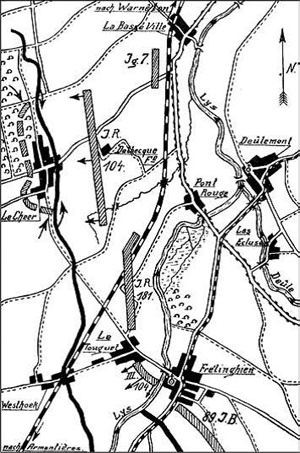
CHAPTER 3 not only covers the lengthy period of trench warfare between the Douve and Lys, but also the major fighting on this front in autumn 1914.
The fighting for Ploegsteert Wood that October and November is covered in much greater detail than the space available in Fighting the Kaiser's War permitted. We describe in detail how trench warfare set in on this front, and how the rudimentary positions established during the battle gradually evolved into a sophisticated trench system.
Naturally we also take a closer look at the Christmas Truce at and near Ploegsteert Wood, as well as the subsequent 'live and let live' arrangement and its implications.
Left: Map from the regimental history of IR 104, showing the situation on 20th October 1914.
Note that at the beginning of November, Kgl. Sächs. 7. Infanterie-Regiment 'König Georg' Nr.106 was committed to the assault on the wood, and subsequently held the line on its eastern edge over Christmas and up until March 1915 (after which IR 104 took over the extended sector as shown in the previous map).
We believe that the situation of IR 181 shown here is that depicted on the postcard below.
Above: This card is the work of an unknown artist from Kgl. Sächs. 15. Infanterie-Regiment Nr.181, the sister regiment of IR 104. It probably depicts their advance from the low ground on the west bank of the Lys up the railway embankment on 20th October 1914, when the Saxons made the first of their many bloody assaults on Ploegsteert Wood.

Above: Sample pages from For King and Kaiser (chapter 3).
CHAPTER 4 draws on the vivid and immediate personal diary of Major (later Oberstleutnant) Alfred von Heygendorff, an experienced veteran commander hurled into the First Battle of Ypres on 23rd October 1914 to take command of Reserve-Infanterie-Regiment Nr. 245, a leaderless and demoralised formation consisting of undertrained volunteers and older reservists.
Major von Heygendorff's diary entries (as preserved by his wdiow) first appeared in the regimental veterans' newspaper in the 1920s, and have never been reprinted or translated since. They were painstakingly transcribed by Jürgen from fragile and exceedingly rare surviving copies of the original newspapers.
For more on the major and his regiment, please see my previous articles:
- The Soul of the Regiment - RIR 245 at Becelaere, October 1914
- A boy scout in the front line - Fritz Lehmann of RIR 245
Our first book Fighting the Kaiser's War includes several vivid personal accounts of the First Battle of Ypres from other units of XXVII. Reservekorps, including that of Einjährig-Freiwilliger Curt Penther of RIR 242.
Above: This picture postcard by an unknown regimental artist depicts the regiment's front line in the In de Ster Cabaret sector (north of Polygon Wood) during the winter of 1914-1915.

Above: Sample pages from For King and Kaiser (chapter 4).
CHAPTER 5 draws on the personal diaries of the regimental commander Major von Heygendorff and battalion commander Hauptmann Curt John to describe the prominent role of Reserve-Infanterie-Regiment Nr. 245 in the Second Battle of Ypres (April-May 1915).
This provides a broader perspective on the battle than one would expect, as the regiment was divided up across two sectors at the time. Its commander was tasked with leading a composite Regiment von Heygendorff (comprising battalions from RIR 245, 246 and 247) in the assault on the Gravenstafel Ridge on the northeastern face of the Ypres salient. Meanwhile Hauptmann John was with the rump of the regiment in its established sector at In de Ster Cabaret, with the simpler mission of keeping as many enemy troops as possible pinned in place opposite.
Left: This sketch is one of a series of portraits of officers of RIR 245 sketched by the talented regimental artist known only as 'E.T.'. All are dated January 1915 (alongside the artist's signature) and were sold as picture postcards, several of which are reproduced in the book. Jürgen has thirteen of them in his collection, but the actual size of the complete series remains unknown. We would be delighted to hear from readers who are in possession of others, or have any information about the elusive 'E.T.'!
This picture is among those which we did not include. Leutnant von Vahl (first name sadly unknown) was a uhlan officer who had originally been responsible for the regimental despatch riders. He was subsequently appointed as Major von Heygendorff's adjutant and can be seen alongside him in several photographs.

Above: Sample pages from For King and Kaiser (chapter 5).
CHAPTER 6 is an updated version of our detailed account of the role of Saxon / Württemberg XXVII. Reservekorps in the Second Battle of Ypres, previously published as the limited edition booklet The Saxons at Zonnebeke (2015).
In addition to the actual offensive and the climactic capture of Zonnebeke by 53. Reserve-Division on 4th May 1915, this chapter also covers the minor engagements which preceded it in the early months of 1915.
One interesting aspect which will certainly surprise many readers is the abortive scheme for Germany's first chlorine gas cloud attack to take place in the XXVII. Reservekorps sector at Polygon Wood. After the infantry had spent months sharing their trenches with the deadly cylinders and repeated false alarms, this plan would ultimately be thwarted by persistently unsuitable wind conditions.
In the (meteorologically highly unlikely) event that the weather had ever been favourable for the original plan, the Second Battle of Ypres would have begun and developed quite differently!
Above: This photo is one of a series depicting the abandoned British / Canadian positions in Polygon Wood after its occupation by Saxon / Württemberg 54. Reserve-Division on 4th May 1915.
Above: This location at the entrance to the chateau grounds beside the church is a familiar one for many WW1 reenactors, although it now looks quite different (due to the subsequent obliteration of this entire area in the Third Battle of Ypres).

Above: Sample pages from For King and Kaiser (chapter 6).
CHAPTER 7 covers the units, facilities and populace of the XXVII. Reservekorps rear area, 1914-1916. The chapter draws on archived corps orders of the day, unit histories and veterans' accounts to introduce the reader to the underappreciated rear area units of the corps, the life led by its combat units when out of the line, and the Flemish population which was obliged to host them.
Units described and depicted in this chapter include:
- Generalkommando (corps HQ)
- Feldgendarmerie (military police)
- Fernsprech-Abteilung (telephonists)
- Feldschlachterei and Bäckerei (butchers and bakers)
- Munitions-Kolonnen (ammunition columns)
- Fuhrpark-Kolonnen (supply park columns)
- Rear-area Kommandos (working parties) and workshops of combat units
The chapter naturally includes a full description of the medical facilities in the corps sector and the various units which operated them.
It also features an illustrated personal account by the Saxon Ortskommandant (town major) of Waterdamhoek, describing his duties and interactions with various other units with considerable wit and colour.
Above: As the caption states, this is the marketplace in Moorslede - a rear-area hub of 53. Reserve-Division up until the reorganisation of the corps front following the shortening of its line as a result of the Second Battle of Ypres (from that point on, only one of the two divisions held the entire corps front at a time). The gun in the foreground is a captured French Canon de 120mm L Mle 1878 de Bange, an obsolete weapon which (like its equivalents in other armies, including the German) was pressed back into active service during the war. Note the signboard on the Ortswache in the background, stating that 'requisitioning without a permit is strictly forbidden'.
Above: This very recently unearthed photo provides a clearer view of the same non-standard (presumably commandeered) ambulance of Reserve-Feldlazarett 92 which can also be seen on p.131 of 'For King and Kaiser', where it is shown standing by to load casualties for transport to Izegem station in late March 1915. Reserve-Feldlazarett 92 was one of the four corps field hospitals, and was based briefly at Dadizele and Moorsele, before moving to Lendelede on 29th October 1914 and finally settling in for the long term at Oekene near Izegem from 6th December 1914.
Note the driver's Pickelhaube and Saxon-pattern artillery sabre, part of the standard uniform of the Saxon Train (supply service) but rarely seen when going about their typically non-martial duties behind the front.
Above: This is one of the small sub-units for which we had no photographic evidence at the time of publication - the Kavallerie-Stabswache at corps headquarters in Dadizele.
This party of permanently assigned HQ guards (seen celebrating Christmas 1915 with their Flemish host) can easily be distinguished from the divisional cavalry detachments of XXVII.RK by their uniforms. The men of Reserve-Kavallerie-Abteilung 53 (53. RD) were uniformed as Saxon uhlans, while Reserve-Kavallerie-Abteilung 54 (54.RD) was a Württemberg formation and must therefore have worn uhlan or dragoon uniform. These cavalrymen however are drawn from one of the Saxon hussar regiments and (in one case) from the Kgl. Sächs. Karabiner-Regiment (2. schweres Regiment).
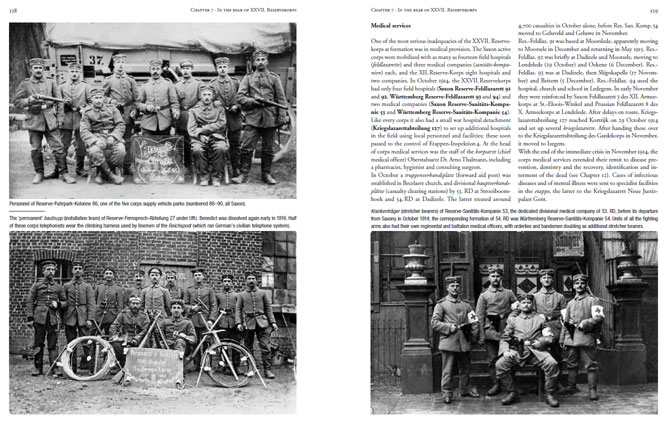
Above: Sample pages from For King and Kaiser (chapter 7).
CHAPTER 8 takes us into the trenches at Wytschaete during the period October 1915 to March 1916, in the witty and erudite company of Leutnant der Reserve Alfred Pache, a recently appointed company commander in Kgl. Sächs. 16. Infanterie Regiment Nr.182. This area is well-known for the preserved Bayernwald trench system, depicted in this chapter in multiple original photographs from October 1915 (note that the modern reconstruction is based on the replacement trenches dug immediately behind the originals, after the latter were ruined by flooding).
The chapter also includes and depicts the communication trench known as the Schweinlesteg or Schweinlesteig, which was recently rediscovered by the Hill 80 archaeological team.
We also chose to cover this sector from the other side, directly comparing Pache's experiences with those of the (at this time, still relatively inexperienced) Canadian units in the trenches opposite.
Please see my previous article A Teacher in the Trenches - IR 182 at Wytschaete, January 1916 for one of Pache's most touching letters, further previously unseen photos and a potted biography, including his spectacular and bloody career with the regiment and his tragic demise in WW2.
Above: This previously unseen photo depicts a company of IR 182 behind the front during the regiment's first tour of the Wytschaete sector in summer 1915.
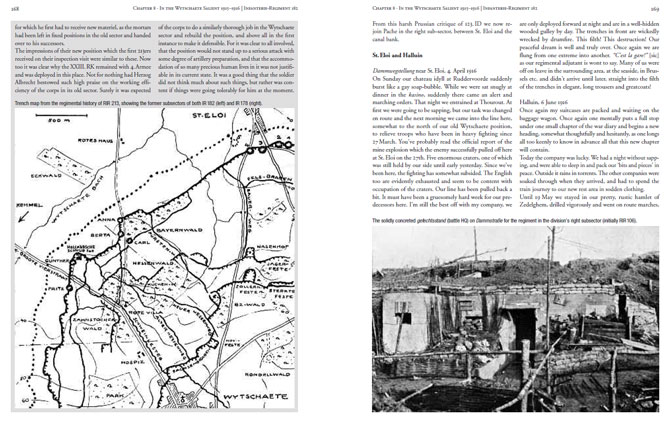
Above: Sample pages from For King and Kaiser (chapter 8).
CHAPTER 9 focuses on the gradual devastation of the Flemish landscape and the progressively worsening conditions during the Third Battle of Ypres in 1917, as experienced by Saxon 23. Reserve-Division at Bixschoote, Pilckem, Langemarck and Passchendaele.
Since this division was deployed on the area of the battle from March until September of that terrible year, we considered them an ideal choice through which to explore the horrific transformation of the whole region around the ruined city.
The emphasis here is not on individual deeds and the details of the fighting, but on the increasingly harsh conditions and their physical and mental effects on the unfortunate men who were inspected to endure them.
In addition to numerous previously unpublished photos from the units of 23. Reserve-Division, we have also 'cheated' a little by including some contemporary pictures from the nearby Prussian Danziger Infanterie-Regiment Nr. 128 which graphically illustrate the hellish state of the battlefield that September.
Above: This photo is one of a series depicting the dignified individual funeral of Sanitäts-Unteroffizier Eduard Herrmann of IR 392 (killed on 20th April 1917) at Manneken Farm on the southern edge of Houthulst Forest. Another picture in the series (with bared heads) appears on p.180 of 'For King and Kaiser'. At this time deaths were still relatively infrequent and received proper individual commemoration. By October this entire area would become a flooded wasteland of anonymous mass death, one of the most hellish places on the entire Western Front. During that terrible phase of the battle, Saxon 40. Infanterie-Division and 58. Infanterie-Division would fight side by side in defence of the poisoned and blasted forest.
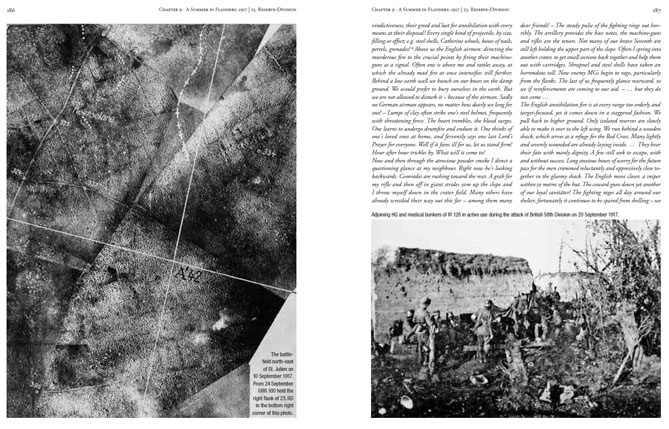
Above: Sample pages from For King and Kaiser (chapter 9).
CHAPTER 10 describes the role of 24. Infanterie-Division at Messines and in the Third Battle of Ypres, focusing on Kgl. Sächs. 9. Infanterie-Regiment Nr.133. It also includes the whole period of offensive preparation and raiding from January 1917 onwards.
The photographic selection includes some amazing and very bleak images from the fighting in the foul mire south of the Menin Road that autumn, where the Saxons repelled the assault of British 7th Division on 26th October. The ragged trenches and the battalion and regimental HQ bunkers are all depicted.
The chapter includes two extremely rare pictures of the Sturmabteilung der 24. Infanterie-Division and brief mention of its documented role in trench raids. We are proud to announce our discovery that the 'red S-shaped snake' sleeve badge (much depicted in articles and books on German storm troops) belonged specifically to this formation!
Like Chapter 8, this chapter also takes a look at the view from the other side, providing corresponding British accounts both of several trench raids and of the major attack of 26th October 1917. The copious British documentation was compared closely to the available Saxon sources, with some interesting results.
Above: This photo shows Leutnant Konrad Mann, adjutant of I. Bataillon / Kgl. Sächs. 14. Infanterie-Regiment Nr.179, together with the battalion's Meldeläufer (runners) in September 1917. This battalion was nearly annihilated in the defence of Gheluvelt on 26th October.
Konrad Mann was born at Staßfurt in Thüringen on 19th September 1895. Although an 'active' (career) officer, he only received his commission in wartime. He was awarded the Ritterkreuz des Militär-St. Heinrichs-Ordens for his leadership of his regiment's 12. Kompagnie in desperate hand grenade fighting on the Somme in August 1916. He was killed in action (initially reported missing) at Montbrehain on 10th October 1918, a disastrous battle described from the perspective of my great-grandfather's Saxon field artillery regiment in a Facebook article: My Great-Grandfather's War: Part 6 (the final battles and post-war)

Above: Sample pages from For King and Kaiser (chapter 10).
CHAPTER 11 describes the experiences of 58. Infanterie-Division at Houthulst Forest, Poelkapelle and Langemarck in the awful final phase of the Third Battle of Ypres, over the following winter and in the spring advance in 1918.
It includes the vivid eyewitness account (taken from his autobiography) of HRH Prince Ernst Heinrich of Saxony, who served in the division with Feldartillerie-Regiment Nr. 115 from October 1917. At his own insistent request, the King of Saxony's youngest son was the only member of the Saxon royal family to serve in a combat role on an active sector of the Western Front. His description of what he saw and experienced as a battery commander in the poisoned remains of Houthulst Forest is by turns moving and horrific.
Please note that the chapter ends at the point when the 58. Infanterie-Division was relieved from its sector near Langemarck on 12th May 1918. We decided that we did not have enough fresh material for it to be worth covering their subsequent tour in the Kemmelberg (Mont Kemmel) sector, which we originally summarised in Fighting the Kaiser's War (that volume also contains the personal story of one of the many who died there).
Above: This photo is taken from the album of a member of Divisions-Funker-Abteilung 14, depicting an infantry immediate reserve (Bereitschaft) position near their radio station in Houthulst Forest. This specialist unit was the only Saxon formation remaining here after the relief of 58. Infanterie-Division at the end of November 1917. The ghastly dead foliage appears spectrally beautiful with its covering of snow. On the western side of the forest, the trees had long been obliterated by the British and French artillery.
Above: This photo is from a group belonging to Leutnant der Reserve Hugo Eberwein of IR 106; another picture from the same group (taken at Houthulst Forest) is featured on p.181 of Fighting the Kaiser's War. Depicted here are old dugouts near the long-destroyed La Truie Farm west of La Basse Ville, which lay in the rear area of 58. Infanterie-Division while it was holding the Kemmelberg in May 1918. La Truie Farm would have been familiar to the surviving veterans of IR 106 from the regiment's time at Ploegsteert Wood (November 1914 to March 1915). Thus after a little over three years, they had come full circle.
Above: The site of La Truie Farm, one of a number of locations misspelled on this 1915-1916 map taken from the regimental history of IR 104.

Above: Sample pages from For King and Kaiser (chapter 11).
CHAPTER 12 is devoted to the cemeteries and monuments of the Saxon Army in Flanders, including the stories of the fallen and an unusual personal account from a wartime regimental graves registration officer. Like all German contingents, the Saxons put enormous effort into recovering, interring and memorialising their dead in elaborate (often unit-specific) cemeteries behind the front. These were fully intended to be just as permanent as those created on foreign soil in previous wars, even as their number and size increased beyond all expectation.
Tragically most of these efforts were swept into oblivion, first by the devastation later in the war of what had once been safe rear areas, and then by the ruinous post-war demands of rent for large swathes of foreign territory ruled by inevitably unsympathetic governments. Hence this chapter offers an insight into an immediate culture of remembrance which has almost entirely disappeared, the remarkably individual and aesthetic grave markers and monuments favoured by the soldiers themselves having now been replaced by the bleak near-anonymity of the concentration cemeteries.
It also touches on the fate of those whose families were wealthy enough to repatriate their remains for burial in Saxony. Such individuals were almost invariably officers, but even for the higher ranks the practice was never universal. Many quite senior Saxon commanders are still buried alongside their men in Belgium and France to this day.
Above: This undated photo shows an Offiziersstellvertreter of IR 133 (or possibly RIR 133) contemplating a devastated civilian cemetery somewhere in northern France.
Above: This is one of a series of photographs depicting the funeral of Major Lucas Kirsten of Kgl. Sächs. 12. Infanterie-Regiment Nr.177. This highly decorated regimental commander (a veteran of the Boxer Rebellion and Southwest Africa, and recipient of both the Ritterkreuz and Komturkreuz 2. Klasse des Militär-St. Heinrichs-Ordens) was killed by a sniper at Warneton on 10th December 1917.
Following a service in the church at Bousbecque (depicted in a photo on p.243 of 'For King and Kaiser'), Major Kirsten's body was transported with full military honours to the railhead for shipment to Saxony at his family's expense. As seen here, the procession not only included his own regiment but also a large contingent of cavalrymen - most likely from 4. Eskadron / Kgl. Sächs. 3. Husaren-Regiment Nr. 20 (the organic cavalry squadron of IR 177's parent 32. Infanterie-Division). There may be a connection here to the fact that the major was himself originally a cavalry officer, having begun his career with Kgl. Sächs. 3. Ulanen-Regiment 'Kaiser Wilhelm II., König von Preußen' Nr.21.

Above: Sample pages from For King and Kaiser (chapter 12).

